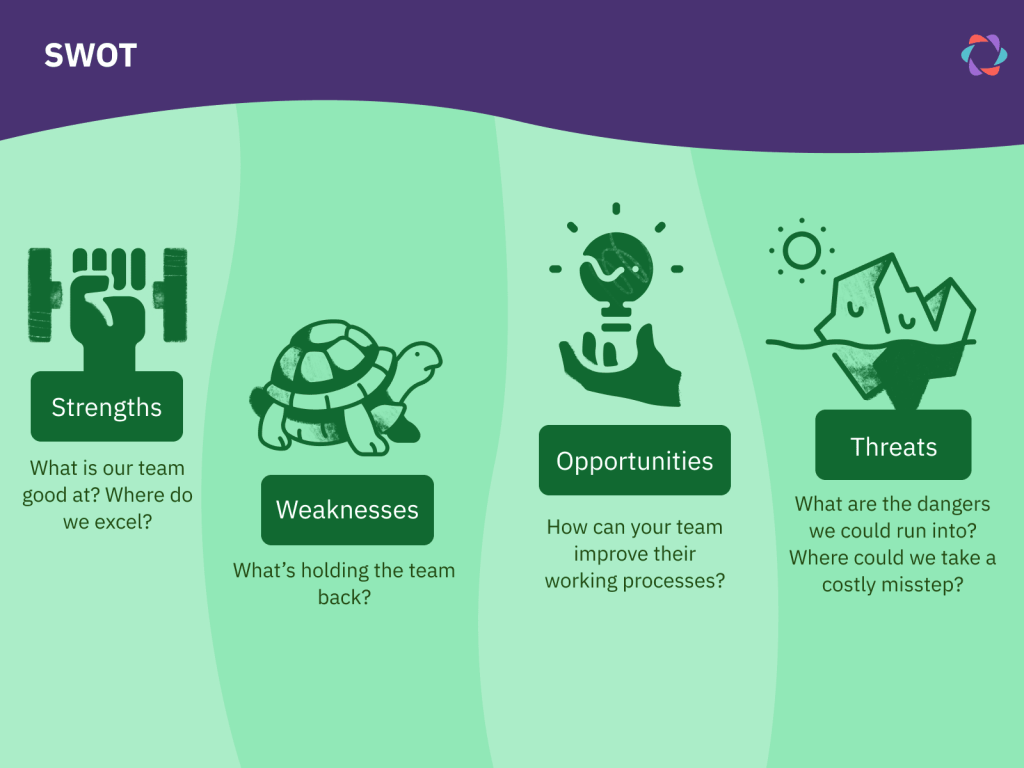75+ SWOT Analysis Questions for Facilitators

Having good questions on hand is the key to turning a good SWOT analysis into a great one. Whether you’re running a personal SWOT analysis at the end of the year, or using the SWOT model to analyze your product or company strategic positioning, questions help us dig deep and uncover detailed insights about our strengths, weaknesses, opportunities, and threats.
By using questions to reach a deeper understanding of our positioning, we are better placed to take the right next steps.
This resource of SWOT analysis questions is designed to help you improve the quality of your analysis and guide you to better answers. You can customize these questions to your own personal situation and use them for either personal SWOT analyses and company SWOT analyses.
Try Parabol’s free SWOT Analysis template to get started immediately

💡Facilitator pro tip: Bookmark this resource and keep it open in a separate tab when you facilitate your SWOT analysis meeting. Pose the questions to your colleagues (or yourself) as you run through the exercise.
Strengths Questions
Interrogating our strengths helps us learn what we’re already good at. Items in your strengths column are good things to double down on or maintain. Take your SWOT analysis to the next level by considering which of your strengths gives you a real competitive edge and is not replicated by your competitors. Then consider what you will do to defend those strengths.
- What advantages do we have over the competition/others?
- What do we do exceptionally well?
- What unique resources or assets do we possess?
- What are our core competencies?
- What is our competitive advantage?
- What is our unique selling point?
- What do people know us for?
- What positive attributes are associated with our brand?
- What is our market share?
- What strong customer relationships do we maintain?
- What past achievements can we leverage?
- What is our financial situation?
- What are our employee’s key strengths?
- What are our own key strengths?
- What technologies or intellectual property do we own?
- What positive trends in the market have we capitalized on?
- What valuable partnerships or alliances do we have?
- What pieces of positive user/peer feedback have we heard?
- What assets or attributes are helping to bring us business?
- What assets or attributes are helping us retain and expand clients?
Weaknesses Questions
Analysing your weaknesses helps you identify areas for improvement. To take your SWOT analysis to the next level, consider which weaknesses are important to fix and which are things you don’t need to convert into strengths as a priority. This will help you make better progress on turning the most high value issues from weaknesses into strengths.
- What are our areas of improvement?
- What do we do poorly or inefficiently?
- What do we struggle with as a company/team/individual?
- Where are we wasting money?
- What practices or actions have a negative or too small return on investment?
- What specific feedback have we heard from users or customer that indicate weaknesses?
- What resources do we lack?
- What are our competitive disadvantages?
- Are there any negative attributes associated with our brand?
- Where do we struggle in terms of winning market share?
- What customer complaints or issues persist?
- What is causing customer/user churn?
- What past mistakes or setbacks have we experienced?
- What is our financial vulnerability?
- What skill gaps exist among our employees?
- What outdated technologies or processes are we using?
- What vulnerabilities exist in our intellectual property?
- What negative trends in the market are affecting us?
- What conflicts or issues exist in our partnerships or alliances?
- What do we not enjoy doing?
Opportunities Questions
After analysing your strengths and weaknesses, think about how you can take advantage of opportunities and turn them into strengths that give you a greater competitive advantage. Improve the quality of your SWOT analysis by going one step further and listing out potential experiments that could help you validate the impact of opportunities. You could use a prioritization framework to help you decide which ones to pursue.
- What emerging market trends or changes can we take advantage of?
- Are there unexplored niches or segments in the market?
- What resources do we have that are currently underutilized?
- What emerging technologies can benefit us?
- Are there underserved customer needs we can address?
- What features/improvements are customers asking for?
- What features/improvements could have the greatest impact on revenue/adoption?
- Are there any changes in regulations or policies that could create opportunities?
- Can we expand our product or service offerings?
- Are there new geographic markets we can enter?
- Are there untapped distribution channels we could pursue?
- Can we leverage our brand reputation in new ways?
- Are there complementary businesses we could partner with?
- What is the potential for growth in our industry?
- Are there new product verticals we should test?
- Can we diversify into related industries?
- Are there opportunities for cost reduction or efficiency improvements?
- Can we introduce new marketing or sales strategies?
- What experiments should we try to validate opportunities?
Threats Questions
Which practices, developments, or issues threaten your competitive positioning? These may be items in your control or out of your control. Use these questions to list out the threats, then think about how you can turn these threats into opportunities or at least mitigate the risk they pose.
- What market trends or changes pose a threat to us?
- Are there new competitors entering the market?
- What new features from competitors could erode our competitive advantage?
- What disruptive technologies might challenge us?
- Are there changes in regulations or policies that could harm us or our business model?
- Are there shifts in customer preferences against our offerings?
- Are there any recurring pieces of customer/user feedback that could result in increased churn?
- Could economic downturns affect our business?
- What is the risk of supply chain disruptions?
- Are there potential legal or litigation threats from any of our operations?
- What are the vulnerabilities in our intellectual property?
- Are there any potential PR or reputational risks we are facing?
- What are the threats to our business from global or geopolitical issues?
- Are there risks associated with our current partners or alliances?
- Could rising costs negatively impact our operations?
- Are there environmental or sustainability threats we need to consider?
Get started with your SWOT analysis
Running a SWOT analysis is an excellent way to begin a structured conversation about your strategic positioning. It’s great for end of year reflection, or at the beginning of planning cycles when you want to set new strategic objectives or OKRs. But you already knew that. That’s why you’re here.
If you want a quick and easy way to collaborate with team-mates on a SWOT analysis, try Parabol’s free SWOT template. You can optionally make input anonymous, start your SWOT with an icebreaker, and also get AI summaries of your meetings and suggestions of what to pursue next.
📚 Further reading: How to Run a Personal SWOT Analysis with Parabol
